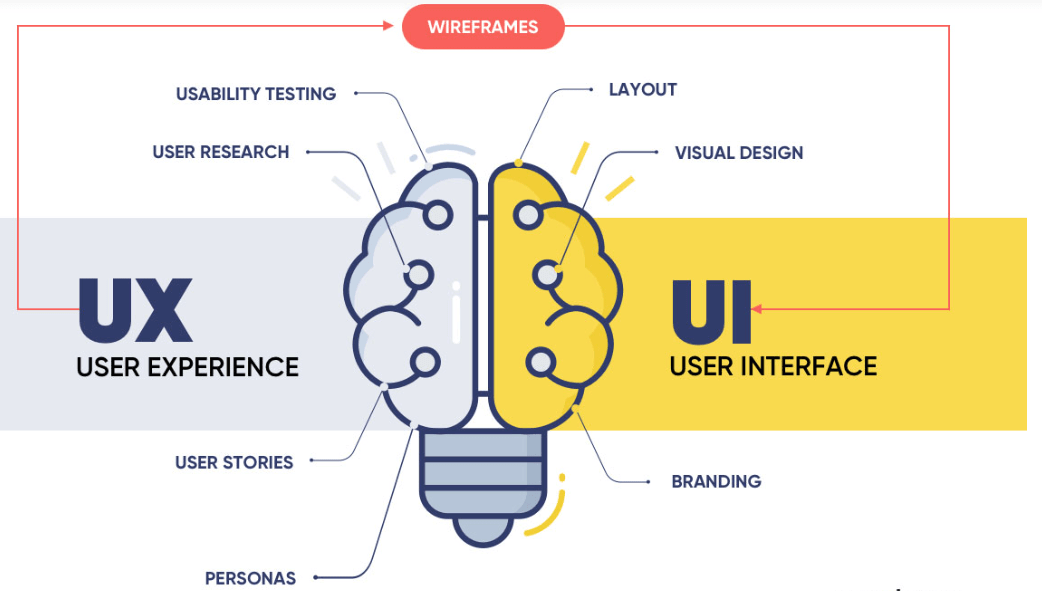User Experience vs User Interface
Dropping the terms UX or UI into a casual conversation is a surefire way to stop it in its tracks, but if you’re a business owner, you ignore these two design principals at your peril. User experience (UX) and user interface (UI) design are critical components of successful digital product or service development.
So successful, in fact, that the generally accepted canon from experienced business leaders is that a return on investment ranging from two to one hundred dollars is yielded for every single dollar invested in UX design.
Given these spectacular results, you’d expect every business to invest heavily in UI or UX design. Not so!
According to a McKinsey report, approximately two out of five businesses surveyed don’t engage with their customers during the development process. More than half confessed that they have no clear way to measure or set desired results for design teams.
If you need another example of UI and UX’s importance, just ask Citibank, who lost 500 million when an employee incorrectly filled out an online form. The reason? Poor usabiloty. Clearly, it’s time everyone took a closer look at these concepts.
If you’re a business owner curious about UX and UI, look no further. In this blog post, we will explain the differences between UX vs UI so that you can make an informed decision about which to use to boost your conversions and ultimately skyrocket your business to success. Keep reading to find out more!
UX designers are charting user pathways. Source: Pexels
What is UX?
Let’s start by discussing what UX is. User experience encompasses all aspects of a person’s interaction with a product or service – from the initial research phase through to purchase and use – and their emotional reaction throughout the entire experience.
At its core, UX is about understanding how people interact with a product or service and using that knowledge to create an improved, enjoyable and meaningful experience for them. It includes usability, accessibility, visual design, information architecture and user research.
The following bullet points encapsulate what user experience is all about:
- Understanding how users interact with a product or service
- Creating an enjoyable and meaningful experience for visitors
- Including elements like usability, accessibility, visual design, information architecture and user research
- Focusing on the technical functionality and emotional engagement of the product or service.
UX has evolved significantly over the past few decades, with technological advances allowing for more simplified designs tailored to individual users’ needs.
UI is concerned with creating beautiful interfaces for customers. Source: LinkedIn
What is UI?
Now you know what UX is, let’s take a look at what UI is all about. At its core, user interface design is concerned with creating an aesthetically pleasing visual experience for users that interacts with the environment in a way that is easy to understand and use.
In short, it’s how you engage with the product or service you’re using. UI design is what makes up the visuals of an application or website – from buttons and icons to fonts and colour schemes – all designed to create a beautiful experience for users.
It also considers usability, accessibility, branding, and other aspects of visual design when creating an effective user interface. Here are some key points that describe UI:
- The look & feel of a product/service
- Visual elements (colours, graphics, fonts)
- Interactions/controls (buttons, sliders, toggles)
- Layouts & templates
- Responsive design
UI has been around for decades. Its evolution is driven by technological advances and the growing expectation that users’ online experience should be beautiful and functional.
Some of the basic differences in skillsets of UI vs UX. Source: Coursera
What’s the Difference Between UX and UI Design?
Have we lost you? That’s alright because both UI and UX are tricky topics to keep straight, and the features of one often overlap with the other. It’s easy to get them confused since they both involve considering how people interact with products and services.
Still, it’s essential to know the difference between them because they will significantly impact your conversions and revenue. UX and UI design are two distinct disciplines that require different skill sets.
The main difference is that while UX focuses on researching user behaviour and designing user experiences, UI focuses on creating interfaces with intuitive visuals.
When it comes to UX vs UI, you can think of it like this: UX is the blueprint and infrastructure for a product, and UI is the paint job that wraps everything together.
Prototypes are plans or mockups of how the site will look. Source: Bootcamp
Design vs prototyping
So the question remains, what’s the difference in skillsets required for UI and UX?
For UX designers, knowledge of user research and testing, prototyping and wireframing are essential for crafting intuitive experiences. In contrast, UI designers must be well-versed in visual design principles like typography, colour theory, grids and layout.
It’s important to note that while UX and UI design are different disciplines, they still work together to create a successful product or service.
An excellent example is when designing an e-commerce website. While the UX designer will focus on creating user journeys that help users find products quickly and easily, the UI designer will come in afterwards to ensure everything looks appealing.
A breakdown of components of UI and UX design. Source: MindInventory
Should I focus on UI design or UX design?
If you’re stuck trying to decide if you should focus on UI design or UX design for a new website, here is a list of clues that may help guide your decision. However we always recommend that both go hand in hand.
UI Should be Your Primary Focus if Your Goal is to:
- Create an aesthetically pleasing website
- Give users an easy-to-navigate website
- Use visuals, graphics and animation to make your website stand out
- You want a visually appealing interface that’s intuitive and user friendly
Signs You Should Focus On UX Design:
- Overall usability of your website is priority one
- You want users to have a positive experience when using the site
- You want to understand what motivates people to visit your site and stay on it for more extended periods
- User engagement is uppermost in your mind
By considering these signs, you should be able to determine which element – UI design or UX design – should take precedence when creating your website. Remember, both elements are equally crucial in ensuring users have a positive experience and can easily navigate the site.
But what if you’ve already had your site up and running for a while? What can you use to guide you in tweaking your site for the better? Your site analytics are a great place to start for this.
So, should you focus on UI or UX design to improve an existing site? Let’s look at your analytics to see what they can tell us.
Consider UI:
- If you’re seeing high bounce rates (people who enter and leave quickly)
- Low page views per session
- Sub-par click-through rate (CTR) on call-to-action buttons and links
Use UI to tweak things like:
- Colour scheme
- Font size/style
- Navigation and button placement
This could go a long way in improving engagement with visitors.
Target UX:
- If you’re seeing high exit rates on certain pages
- Low conversions and long load times
Use UX to:
- Streamline processes within the site
- Update copy
- Make sure that all options are straightforward to understand
Think about addressing both UI and UX if you see a mix of all these things. User interface improvements can help with engagement, while user experience tweaks can ensure visitors don’t get hung up during their journey through your website.
Analytics gives us so much insight into how people interact with our websites, so use them to your advantage when deciding which area of design you should focus on. With the right tweaks and adjustments, you can make sure that your site’s visitors have a great experience while they’re there!
Frequently Asked Questions About UX Design
1. Is UX design the same as UI design?
No, UX and UI design are distinct disciplines with different focuses. UX design is about creating an intuitive, user-friendly experience for customers, while UI design focuses on the look and feel of the interface.
2. What Comes First, UX or UI?
There’s much debate about which should come first regarding UX vs UI. Should we focus on the user experience or the user interface? The answer is that both are important and intertwined – but when discussing them in terms of high-level vs details, UX should generally come first.
High-level vs details
User experience design focuses on understanding customer needs and motivations, researching product usage patterns, building prototypes for testing, and designing features that will provide a great overall user experience. It’s more than aesthetics; UX designers consider how users interact with products psychologically.
On the other hand, user interface design is all about creating an aesthetically pleasing front end. It’s concerned with how buttons and menus look in size, colour, shape and position.
UI designers aim to create an interface that is visually appealing and easy to use. When it comes to UX vs UI, UX should go first as it focuses on understanding customer needs and motivations at a high level before diving into details like aesthetics or user interfaces.
This approach ensures that the product is designed from a user-centric perspective rather than just making something look pretty but useless for users.
Look vs feel
So which should get more weight, the look or the feel of your website? Think about a website like a car. On the one hand, you want it to look good or have a pleasing UI. But the UX is just as important – you want it to drive well and be easy to use.
This is true for websites, too: if you’re building a digital space, both the look and feel are essential components of success. The key takeaway? When creating an effective website design that meets user needs, don’t overlook either UI or UX; they contribute equally to overall user satisfaction.
Make sure you understand UX and UI and consider how each element affects your site design before launching!
UX and UI rely on each other to create seamless user interaction. Source: Net Solutions
How do UX Design and UI Design Work Together?
Now that you’re reasonably conversant with the differences between UI and UX design, let’s explore how these concepts work together to create an easy, intuitive user journey through your platform.
For example, if you’re developing an e-commerce store, your UX designer would plan out the customer journey from start to finish, looking at:
- What products they’ll see first when they land on your home page
- What steps they’ll need to take to make a purchase
- How the checkout process is structured
On the other hand, your UI designer would focus on creating an interface that’s easy for customers to navigate, such as:
- Strategically placed buttons that drive conversions
- Eye-catching visuals that draw them in
- Fonts that are easy to read
When UX and UI design are done correctly, users should feel like their experience is intuitive.
What’s the Role of Research in the UX/UI Design Process?
To say research plays a huge role in user experience and interface design would be a huge understatement. Research is the backbone of a successful UX/UI design process.
As business owners or designers, it’s your job to truly understand the needs of your users and what they value most in their experience with our product or service. Research helps you gain that understanding so that you can create designs that are tailored to their needs and preferences.
There are multiple ways to conduct research when it comes to UX/UI design. For example, conducting interviews and surveys can be incredibly useful for learning more about people’s experiences using your product or service.
We can also observe user behaviour and collect data on how people interact with products and services. In addition to user research, designers should conduct market research to understand the competitive landscape and gain insights into what’s working well for other companies.
This can help inform design decisions and ensure that we’re on track to create a product or service that is competitive with others on the market. At the end of the day, research is essential regarding UX/UI design because it helps us create interactions tailored to our users’ needs, values, and preferences.
Without conducting thorough research at each stage of the process, we risk creating a product or service that fails to meet user expectations.
Upcoming Trends in UX and UI Design
As technology advances, so do user experience and user interface. Mobile devices, voice technologies, and virtual reality are a few emerging solutions shaping how we interact with UX/UI.
- Mobile. The number of people using mobile phones as their primary device for accessing the internet is increasing rapidly. This means that designers must develop websites and applications that look great on smaller screens.
Responsive mobile design is an essential factor when it comes to achieving favourable UX/UI on mobile devices. Additionally, having a well-designed app can enhance users’ experiences even further by providing them with an intuitive interface and a consistent experience across multiple devices.
- Voice Technology. Voice technology is becoming an increasingly popular way to interact with websites and applications. With natural language processing (NLP), users can talk to their devices using voice commands, eliminating the need for typing or clicking.
Designers must consider incorporating voice technology into their designs to provide users with a seamless experience that feels natural and efficient.
- Virtual Reality. Virtual reality (VR) has been gaining popularity as more companies explore its potential for creating immersive experiences. VR allows designers to create realistic 3D environments where users can interact with objects and explore different scenarios.
As UX/UI designers continue to adapt their designs for the future of technology, mobile, voice technologies, and virtual reality will become increasingly important considerations.
Designers need to ensure that their designs are optimised for these new mediums to provide users with an enjoyable experience that keeps them returning for more.
Are You Team UX or UI?
So, are you team UX or team UI? The truth is, it’s not competition. They go hand-in-hand, and great user experiences rely on both user interface and user experience design.
Businesses should pay attention to the power of UX and UI. Both help to create a great customer experience that can drive sales, loyalty, and long-term customer relationships.
If you want to improve your product or website design, consider investing in user experience and interface design with Squibble. We believe that good design can make people take a stand.
Our mission is to create designs that move your customers into action. Once we understand their wants and needs, we’ll get them excited to join in! Reach out, and let’s talk about you and your goals for success!







